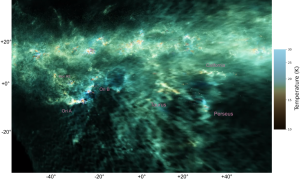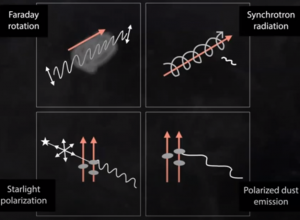2024 Possible Summer Research Projects
Title: The secret life of over-dense regions in interstellar turbulence
Supervisor: Dr. James Beattie (Princeton & CITA)
The initial conditions for star formation are embedded in the fractal gas density structures produced by supersonic, magnetised turbulence. We understand in a lot of detail relations between the global statistical properties and moments of the gas density field. However, we do not understand the local properties of the densest regions, which are just as, if not more important than the global properties, for understanding the star formation process. Roberston & Goldreich (2018) demonstrated how to identify, cluster and track in time over-dense regions by using a mixture of Lagrangian and Eulerian plasma statistics, unveiling a host of important properties of the dense regions in hydrodynamical turbulence. In this project we will do the same for magnetohydrodynamical turbulence, with the student contributing to a clustering and local statistical analysis code that has already been written by Dr. James Beattie. With some further software development, we will add time tracking, and the ability to generalise this code to other interesting structures in the magnetised turbulence, such as current sheets. There will also be opportunities to do an analytical analysis of the local statistical properties, such as the density profile, of the regions as the project progresses. This project will lead to significantly better understanding of not only the initial conditions for star formation, but also the role of strong gas density fluctuations in a magnetised, turbulent medium.
_______________________________________________________________________________________________________________
Title: Reconstructing three-dimensional moments from anisotropic two-dimensional fields
Supervisor: Dr. James Beattie (Princeton & CITA)
Many astrophysical observations are intrinsically two-dimensional in position-position space (PP; e.g., a column density map). However, astrophysical plasma models are usually constructed in three-dimensions, position-position-position (PPP), so an important step to compare theory to observations is therefore being able to reconstruct the statistics of the three dimensional field from two dimensional observations. Important work from Brunt et al. (2010) showed that one could, under the assumption of isotropy, reconstruct the three-dimensional variance of a turbulent (or generally stochastic) field by using a rotational transformation of the power spectrum. But in the presence of strong magnetic fields, which we find on many scales in a galaxy, isotropy is strongly violated. Hence, this project aims to utilise analytical means to generalise the Brunt et al. (2010) method to include the ability to reconstruct anisotropic fields. Furthermore, we will validate our new method on a suite of high resolution magnetohydrodynamical turbulence simulations.
_______________________________________________________________________________________________________________
Title: Supersonic vortices: understanding the building blocks of supersonic, sub-Alfvénic magnetohydrodynamic turbulence.}\\
Supervisor: Dr. James Beattie (Princeton & CITA)
Strongly magnetised, compressible turbulence is ubiquitous in the solar wind, atmosphere of compact objects, and even cold molecular and atomic gas distributed across the Galaxy. Beattie, et al. (2020b,2022a,2022c) has shown that in this regime of turbulence the energy budget is dominated not by turbulent nor Alfvénic fluctuations, as previously assumed, but rather rigid body vortices that are self-organised into a quasi-stationary state that give rise to non-classical dissipation, non-local intermittency effects, and peculiar decay characteristics that are currently not captured by any turbulence phenomenology. By utilising both computational and analytical techniques, in this project, we aim to (1) build a vortex tracking code to use on high-resolution, three-dimensional turbulence data, so that we can extract and characterise the local dynamics that give rise to, maintain, and eventually decay these vortices; and (2) explore the stability and signature of these vortices in linear eigenmode decompositions of the turbulent plasma. These results will have fundamental repercussions for not only strongly magnetised compressible turbulence theory (e.g., residual energy theory), but also for GeV cosmic ray transport, and the measurement of interstellar magnetic fields using Davis-Chandreshkar-Fermi methods.
_______________________________________________________________________________________________________________
Title: Identifying Exotic Matter Within Neutron Stars
Supervisors: Reed Essick and Utkarsh Mali
Neutron stars contain the densest matter anywhere in the universe, and the exact behaviour of nucleons in such situations is not fully understood. It is possible that exotic phases of matter exist in the cores of the heaviest neutron stars. This project will investigate the ability to identify these states directly from the observable properties of neutron stars, like their masses and radii.
The student will develop new algorithmic approaches to identify subtle features in the neutron star structure. The applicant is expected to have knowledge of scientific programming, preferably with experience in Python. No prior astrophysics knowledge is required.
_______________________________________________________________________________________________________________
Title: Deciphering the Structure of Molecular Clouds with Neural Networks
Supervisors: Marta Reina-Campos and Shivan Khullar
Giant Molecular Clouds (GMCs) are the sites of most star formation in the universe. is a rich multi-scale multi-physics problem. Using observations, we can only see 2D projections of 3D objects in the sky and are thus limited to inferring quantities from such projections. On the other hand, in simulations, we can measure everything in 3D and 2D in addition to knowing the precise physics. Galaxy simulations are now able to resolve the structure and star formation properties of GMCs. In this project, the student will use state-of-the-art simulations of galaxies to first identify GMCs. We will then use neural networks to map 3D GMC properties in simulations to 2D observables, and then reverse the problem to use observations of GMCs in order to get 3D information out of 2D observable quantities. The student will gain knowledge about numerical simulations, data analysis and machine learning methods, as well as develop programming skills like using git and python modules such as TensorFlow/PyTorch.
_______________________________________________________________________________________________________________
Title: 3D Universe Mapping: Unraveling Cosmic History with the 21-cm Line of Neutral Hydrogen
Supervisor: Jennifer Yik Ham Chan
This undergraduate summer research project offers student an exciting opportunity to delve into the field of astrophysics and cosmology by exploring the 3D mapping of the Universe. Focusing on the 21-cm line of neutral hydrogen, a key tool in cosmic measurements, the project will guide student through exploring the key periods in the Universe’s history: the Dark Ages, the Cosmic Dawn, and the Epoch of Reionization.
Student will gain a deep understanding of how cosmic information is imprinted onto the radiation we receive and the processes influencing the observed spectra. They will engage with theoretical and computational tools to model and interpret cosmic phenomena. They students will gain hands-on experience of numerically solving cosmological radiative transfer equation, visualizing cosmological simulation outputs, and interfacing the 21-cm line radiative transfer with simulation products to predict the observables.
This project is designed to equip students with both theoretical knowledge and practical skills, paving the way for future explorations in astrophysics and cosmology.
_______________________________________________________________________________________________________________
Title: Using Gravitational Waves to Probe the Cosmos
Supervisor: Aditya Vijaykumar
Detection of gravitational waves (GWs) from colliding black holes and neutron stars has become commonplace, and has opened up a unique observational window in astronomy and astrophysics. These detected GW signals can be used to answer a variety of questions such as:
1. When and where do these black holes and neutron stars form?
2. What are the various processes driving their formation and evolution?
3. What are the properties of the intervening matter between the objects and the earth?
As a part of this project, the SURF student will explore this exciting field and answer questions of the nature posed above. The student will learn about strong gravity, stellar evolution, and also some advanced data analysis techniques. There are also avenues to interface with concepts in gravitational lensing (i.e. the bending of light/GWs around massive objects), as well as concepts in the structure and evolution of galaxies. The student will be embedded in the Compact Objects research group at CITA, and will have a chance to participate in all activities of the group.
_______________________________________________________________________________________________________________
Title: Unraveling the Radiative Properties of the Interstellar Medium
Supervisor: Ioana Zelko
A comprehensive 3D map of the properties of dust can serve as a great probe for the interstellar medium (ISM), as well as the radiation field of the galaxy, which plays a critical role in many applications, including physics of the galactic magnetic fields, polarization measurements, modeling of the diffuse Galactic gamma-ray emission, and star formation.
Previous work(1)has combined existing 3D maps of the reddening (-> density) of the dust in the ISM, with emission observed by Planck and IRAS at five frequency bands, to create a 3D temperature map2 of the interstellar dust temperature, at resolutions of 27’ (see figure below).
In this project, the student can build on the 3D dust temperature map to explore potential applications: correlations with star forming regions with other data catalogs, interstellar radiation field calculation, dark matter, magnetic fields, as well as other ideas. Resolution matching will likely play a role in determining the feasibility of the application.
The student will gain knowledge of theory, data analysis, statistics and programming, with the possibility of practicing oral, visual, and written science communication and publication. Project details can change to match the students skills and interests.
1 https://arxiv.org/pdf/2211.07667.pdf
2 https://www.youtube.com/playlist?list=PLijDPBNhGIqQccgN0BKJciE16NJ1PtsdO
Figure description: 3D visualizations of the 27′ resolution map of the temperature of galactic dust and its density. Perspective shown in the galactic plane towards the anti-center (180◦ galactic longitude), towards the Orion, Taurus, Perseus, and California clouds. Credit: Zelko et al. 2022.

_______________________________________________________________________________________________________________
Title: Measuring the Morphology of the Galactic Magnetic Field in 3D
Supervisors: Ioana Zelko
Measuring the Morphology of the Galactic Magnetic Field in 3D
Galactic magnetic fields, including those in the Milky Way, are key in astrophysical processes. They influence star formation, galaxy evolution, and the dynamics of the interstellar medium, impacting gas movement and temperature. These fields shape galactic structures like spiral arms and affect cosmic ray acceleration and synchrotron emission, important for studying the epoch of reionization. Understanding their morphology is crucial, but their line-of-sight morphology as a function of position remains unknown
In this project, the student will have the opportunity to characterize the morphology of the magnetic field along the line of sight. This will be achieved by utilizing the polarization properties of interstellar medium dust, which effectively trace the field’s orientation. Building upon the methodologies established in prior research(1), which successfully generated the first large scale 3D dust temperature map(2), this project aims to enhance our understanding of the magnetic field’s 3D morphology. Additionally, the student will have the chance to investigate other methods that probe different facets of the magnetic field’s structure, further enriching this study.
The student will gain knowledge of theory, data analysis, statistics and programming, with the possibility of practicing oral, visual, and written science communication and publication. Project details can change to match the students skills and interests.
1 https://arxiv.org/pdf/2211.07667.pdf
2 https://www.youtube.com/playlist?list=PLijDPBNhGIqQccgN0BKJciE16NJ1PtsdO
Figure description: Complementary probes of the components of the galactic magnetic field. Figure credit: Susan Clark

_______________________________________________________________________________________________________________